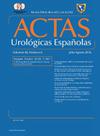确定开放性根治性膀胱切除术中切除的危险因素
IF 1.2
4区 医学
Q3 UROLOGY & NEPHROLOGY
引用次数: 0
摘要
腹壁闭合缺陷是剖腹手术患者发病和死亡的原因之一。目的探讨开放性根治性膀胱切除术中导致腹壁闭合缺陷的危险因素。方法对2018年1月至2021年12月在Castellón大学综合医院行开放性膀胱癌根治性膀胱切除术的患者进行回顾性、分析性、观察性、描述性和多因素分析。结果共纳入80例患者。平均年龄70岁,男性占86.3%。16例出现内脏切除(20%)。多因素分析的危险因素包括年龄、血管或冠状动脉病史、术前白蛋白、血流动力学不稳定和手术时间。8例患者出现evation(10%)。较高的身体质量指数和较低的术前血红蛋白水平与evation有关。结论与腹壁闭合缺陷相关的危险因素是可识别和可预防的。本文章由计算机程序翻译,如有差异,请以英文原文为准。
Identificación de los factores de riesgo de evisceración en la cistectomía radical abierta
Introduction
Abdominal wall closure defects represent a cause of morbidity and mortality in patients undergoing laparotomy.
Objective
The aim of this study was to determine the risk factors contributing to the appearance of abdominal wall closure defects in open radical cystectomy.
Methods
A retrospective, analytical, observational, descriptive study and multivariate analysis was conducted including patients who underwent open radical cystectomy for bladder cancer at the General University Hospital of Castellón between January 2018 and December 2021.
Results
A total of 80 patients were included. The mean age was 70 years, with 86.3% being men. Sixteen presented with an evisceration (20%). Risk factors in the multivariate analysis were age, history of vascular or coronary disease, preoperative albumin, hemodynamic instability, and surgical time. Eight patients presented with an eventration (10%). A higher body mass index and a lower preoperative hemoglobin level were associated with eventration.
Conclusion
The risk factors associated with abdominal wall closure defects are identifiable and preventable.
求助全文
通过发布文献求助,成功后即可免费获取论文全文。
去求助
来源期刊

Actas urologicas espanolas
UROLOGY & NEPHROLOGY-
CiteScore
1.90
自引率
0.00%
发文量
98
审稿时长
46 days
期刊介绍:
Actas Urológicas Españolas is an international journal dedicated to urological diseases and renal transplant. It has been the official publication of the Spanish Urology Association since 1974 and of the American Urology Confederation since 2008. Its articles cover all aspects related to urology.
Actas Urológicas Españolas, governed by the peer review system (double blinded), is published online in Spanish and English. Consequently, manuscripts may be sent in Spanish or English and bidirectional free cost translation will be provided.
 求助内容:
求助内容: 应助结果提醒方式:
应助结果提醒方式:


